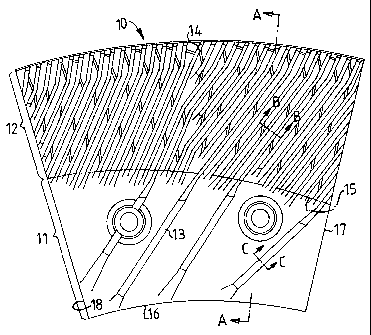Some of the information on this Web page has been provided by external sources. The Government of Canada is not responsible for the accuracy, reliability or currency of the information supplied by external sources. Users wishing to rely upon this information should consult directly with the source of the information. Content provided by external sources is not subject to official languages, privacy and accessibility requirements.
Any discrepancies in the text and image of the Claims and Abstract are due to differing posting times. Text of the Claims and Abstract are posted:
| (12) Patent Application: | (11) CA 2552762 |
|---|---|
| (54) English Title: | REFINING ELEMENT |
| (54) French Title: | ELEMENT DE RAFFINAGE |
| Status: | Deemed Abandoned and Beyond the Period of Reinstatement - Pending Response to Notice of Disregarded Communication |
| (51) International Patent Classification (IPC): |
|
|---|---|
| (72) Inventors : |
|
| (73) Owners : |
|
| (71) Applicants : |
|
| (74) Agent: | SMART & BIGGAR LP |
| (74) Associate agent: | |
| (45) Issued: | |
| (86) PCT Filing Date: | 2005-01-17 |
| (87) Open to Public Inspection: | 2005-08-04 |
| Availability of licence: | N/A |
| Dedicated to the Public: | N/A |
| (25) Language of filing: | English |
| Patent Cooperation Treaty (PCT): | Yes |
|---|---|
| (86) PCT Filing Number: | PCT/SE2005/000035 |
| (87) International Publication Number: | SE2005000035 |
| (85) National Entry: | 2006-07-06 |
| (30) Application Priority Data: | ||||||
|---|---|---|---|---|---|---|
|
A refining element intended for refiners of disc-type for working fibrous
material, where the refining element (10) is provided with a pattern of bars
(13, 14) and intermediate grooves, and the refining element (10) is divided
into an inner in-feed portion (11) with coarse bars (13) and an outer portion
(12) with fine bars (14). The transition (15) between the inner portion and
outer portion (11 and 12, respectively) extends arc-shaped over the refining
element at varying distance from the inner edge (16) of the refining element.
La présente invention concerne un élément de raffinage destiné à des raffineurs du type à disque utilisés pour travailler les matières fibreuses. L'élément de raffinage (10) est prévu avec une configuration de barres (13, 14) et de rainures intermédiaires, ledit élément de raffinage (10) étant divisé en une partie intérieure d'entrée (11) dotée de grosses barres (13) et d'une partie extérieure (12) dotée de fines barres (14). La transition (15) entre la partie intérieure et la partie extérieure (11 et 12) s'étend en forme d'arc au-dessus de l'élément de raffinage à une distance variable du bord interne (16) de l'élément de raffinage.
Note: Claims are shown in the official language in which they were submitted.
Note: Descriptions are shown in the official language in which they were submitted.

2024-08-01:As part of the Next Generation Patents (NGP) transition, the Canadian Patents Database (CPD) now contains a more detailed Event History, which replicates the Event Log of our new back-office solution.
Please note that "Inactive:" events refers to events no longer in use in our new back-office solution.
For a clearer understanding of the status of the application/patent presented on this page, the site Disclaimer , as well as the definitions for Patent , Event History , Maintenance Fee and Payment History should be consulted.
| Description | Date |
|---|---|
| Application Not Reinstated by Deadline | 2011-01-17 |
| Time Limit for Reversal Expired | 2011-01-17 |
| Inactive: Abandon-RFE+Late fee unpaid-Correspondence sent | 2010-01-18 |
| Deemed Abandoned - Failure to Respond to Maintenance Fee Notice | 2010-01-18 |
| Letter Sent | 2006-11-08 |
| Inactive: Single transfer | 2006-10-17 |
| Inactive: Courtesy letter - Evidence | 2006-09-19 |
| Inactive: Cover page published | 2006-09-14 |
| Inactive: Notice - National entry - No RFE | 2006-09-11 |
| Application Received - PCT | 2006-08-17 |
| National Entry Requirements Determined Compliant | 2006-07-06 |
| Application Published (Open to Public Inspection) | 2005-08-04 |
| Abandonment Date | Reason | Reinstatement Date |
|---|---|---|
| 2010-01-18 |
The last payment was received on 2008-12-19
Note : If the full payment has not been received on or before the date indicated, a further fee may be required which may be one of the following
Patent fees are adjusted on the 1st of January every year. The amounts above are the current amounts if received by December 31 of the current year.
Please refer to the CIPO
Patent Fees
web page to see all current fee amounts.
| Fee Type | Anniversary Year | Due Date | Paid Date |
|---|---|---|---|
| Basic national fee - standard | 2006-07-06 | ||
| MF (application, 2nd anniv.) - standard | 02 | 2007-01-17 | 2006-07-06 |
| Registration of a document | 2006-10-17 | ||
| MF (application, 3rd anniv.) - standard | 03 | 2008-01-17 | 2008-01-03 |
| MF (application, 4th anniv.) - standard | 04 | 2009-01-19 | 2008-12-19 |
Note: Records showing the ownership history in alphabetical order.
| Current Owners on Record |
|---|
| METSO PAPER, INC. |
| Past Owners on Record |
|---|
| LARS HOLMSTEN |
| NILS VIRVING |
| PERTTI PUROLAINEN |